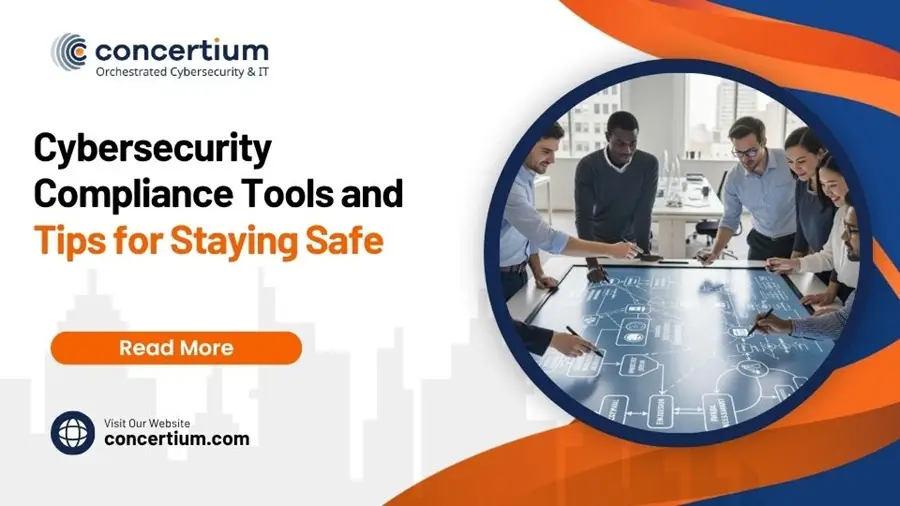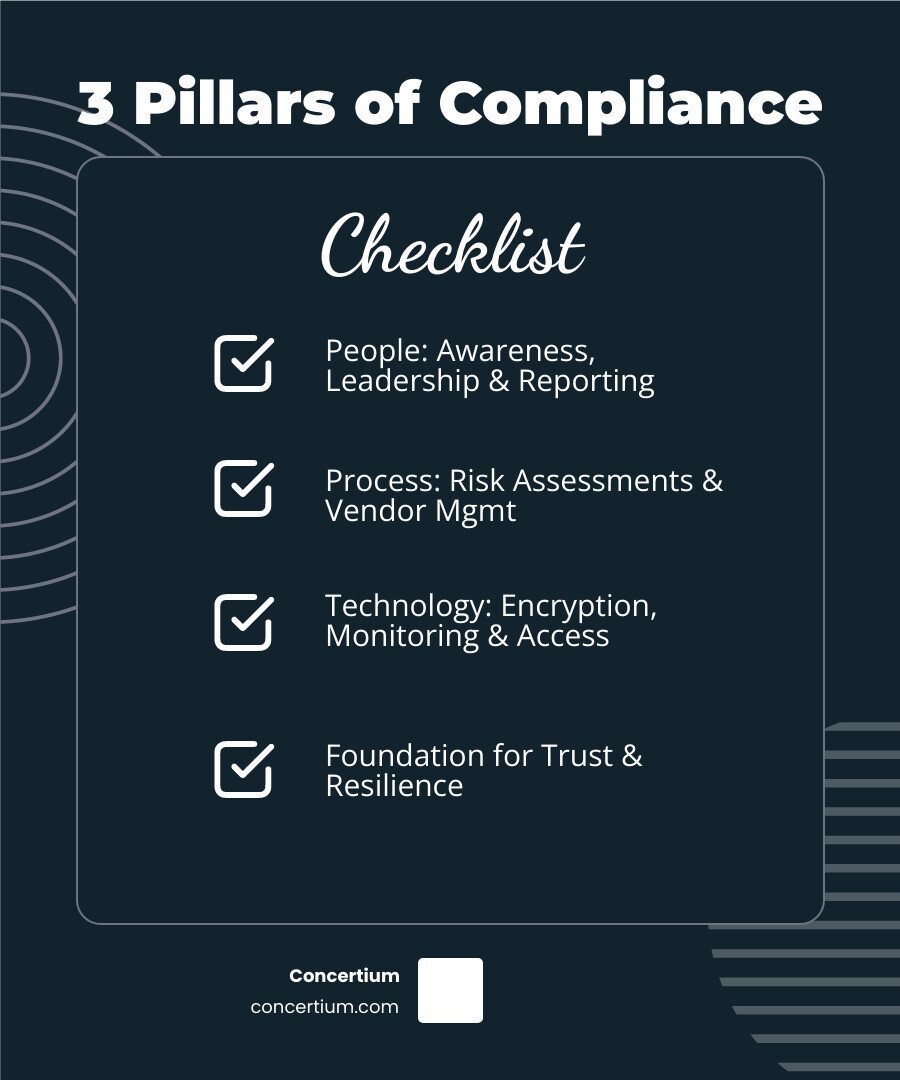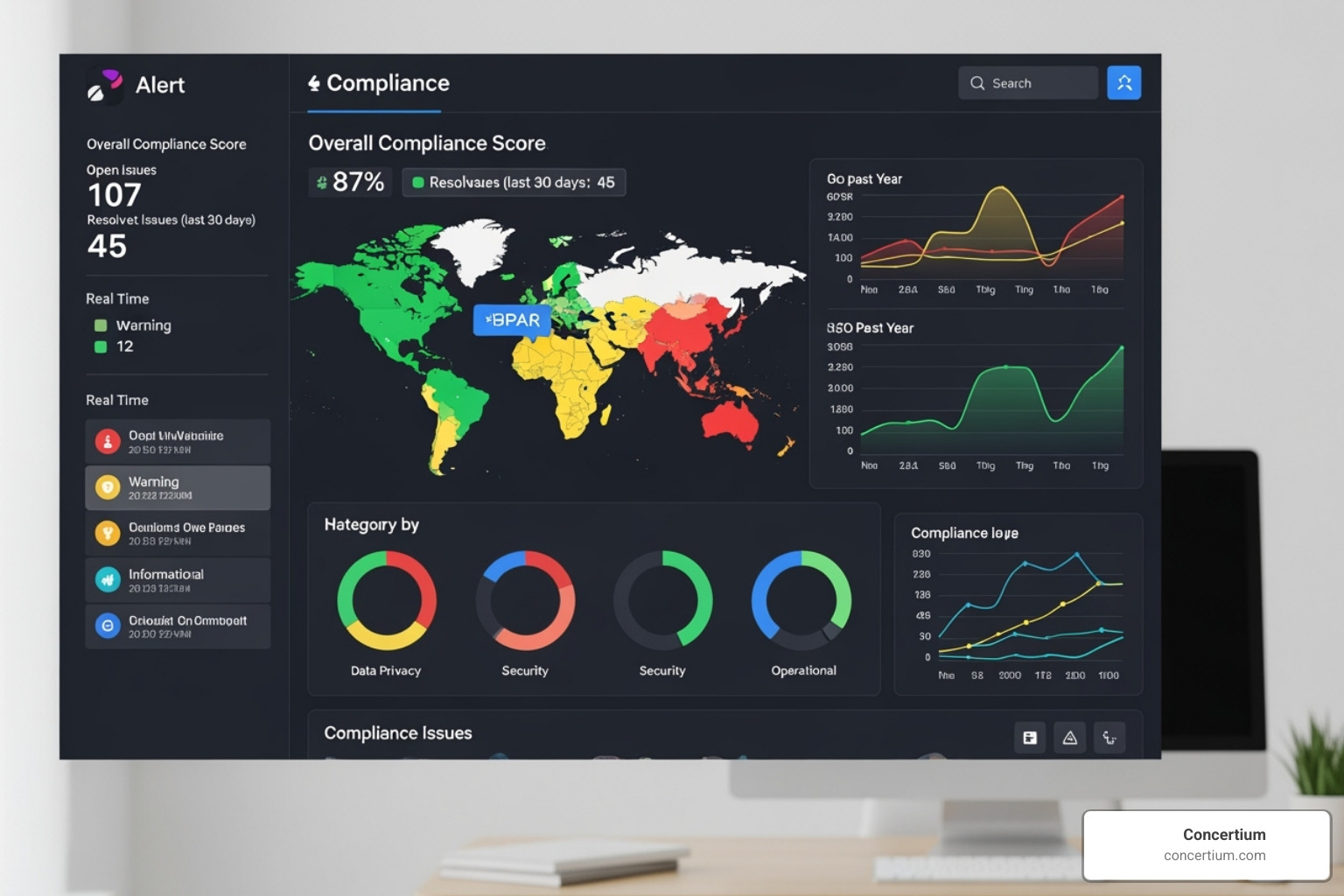AI Overview:
Cybersecurity compliance is no longer just a regulatory requirement—it’s a survival strategy. With ransomware attacks up 95% in 2023 and the average breach costing $4.88 million, organizations must adopt best practices that protect sensitive data, maintain customer trust, and safeguard against legal and financial fallout.
Cybersecurity Compliance Best Practices 2024: Secure
Why Cybersecurity Compliance Best Practices Are Critical for Your Business
Cybersecurity compliance best practices are essential frameworks and procedures that help organizations protect sensitive data while meeting regulatory requirements. With ransomware attacks surging by 95% in 2023 and the average data breach costing $4.88 million, implementing these practices isn’t just smart business—it’s survival.
Essential Cybersecurity Compliance Best Practices:
- Conduct regular risk assessments to identify vulnerabilities
- Implement strong access controls and multi-factor authentication
- Train employees regularly on security awareness and threat recognition
- Maintain detailed documentation of all security policies and procedures
- Develop comprehensive incident response plans with regular testing
- Monitor systems continuously for threats and compliance gaps
- Manage third-party vendor risks through contract reviews and assessments
- Keep systems updated with latest security patches
- Encrypt sensitive data both at rest and in transit
- Perform regular internal audits to validate compliance status
The reality is stark: 74% of all cyber breaches are caused by human factors, making compliance training and awareness programs critical. Organizations that ignore these practices face severe consequences including GDPR fines up to €20 million or 4% of global revenue, operational disruption, and devastating reputation damage.
But compliance isn’t just about avoiding penalties. It’s about building customer trust, reducing cyber insurance costs, and creating operational resilience that gives your business a competitive edge.
Modern compliance requires a three-pronged approach combining people, processes, and technology. Leadership commitment drives the culture, structured processes manage risks, and automation tools streamline monitoring and reporting.
Cybersecurity compliance best practices terms made easy:
Think of cybersecurity compliance best practices as a GPS for navigating the complex digital world. A strong compliance posture offers benefits far beyond avoiding fines. The most obvious is a reduced risk of breaches, helping you sidestep the staggering $4.88 million average cost of a data breach. A robust program also improves your organizational reputation, building invaluable trust with customers and partners.
Conversely, the consequences of non-compliance are devastating, including hefty fines (GDPR penalties can reach €20 million or 4% of global revenue), legal action, and severe reputational harm.
Here are the major regulations and frameworks that most organizations need to steer: GDPR for EU data protection, HIPAA for healthcare information, CCPA for California consumer privacy, PCI DSS for payment card security, NIST Cybersecurity Framework for comprehensive risk management, ISO 27001/27002 for information security standards, SOC 2 for service organization controls, and FISMA/NIST 800-53 for federal systems.
Key Regulatory Requirements
The regulatory landscape might seem complex, but each law serves a specific purpose in protecting sensitive information.
- GDPR (General Data Protection Regulation): This EU law applies to any company handling data from EU citizens. It demands explicit consent for data collection, grants individuals rights over their data, and requires breach notifications within 72 hours.
- HIPAA (Health Insurance Portability and Accountability Act): Essential for healthcare, HIPAA mandates robust controls for securing electronic health information, including regular risk assessments and detailed audit trails.
- PCI DSS (Payment Card Industry Data Security Standard): This standard governs any entity that handles credit card information. Non-compliance can trigger monthly penalties from $5,000 to $100,000.
- CCPA (California Consumer Privacy Act): This state-level law grants California residents extensive rights over their personal information and requires businesses to implement reasonable security measures.
These regulations impact businesses by dictating security measures, data management practices, and incident response requirements. Non-compliance creates a three-pronged threat: financial damage, legal exposure, and reputational destruction.
Security Frameworks for Compliance
While regulations tell you what to do, security frameworks show you how.
- NIST Cybersecurity Framework (CSF): The gold standard for cyber risk management, NIST CSF 2.0 provides a common language for organizations across all sectors to govern and manage cyber risk.
- ISO 27001/27002: These international standards provide the framework for an Information Security Management System (ISMS) and offer detailed guidance on implementing security controls, demonstrating a global commitment to security.
- SOC 2 (Service Organization Control 2): Essential for service organizations, especially cloud providers, SOC 2 reports verify that vendors securely manage client data according to over 60 compliance requirements.
- FISMA (Federal Information Security Modernization Act) and NIST 800-53: These protect U.S. federal government information systems. NIST 800-53 provides a comprehensive catalog of controls for federal agencies and their contractors.
These frameworks support compliance and risk management by providing systematic approaches to identifying vulnerabilities, implementing controls, and continuously monitoring your security posture.
Laying the Groundwork: Strategy, Culture, and Planning
Effective cybersecurity compliance best practices start with a solid foundation, not technical tools. This groundwork begins with leadership commitment, demonstrated through dedicated resources, personnel, and training. This fosters a security-first culture where cybersecurity becomes everyone’s responsibility, not just the IT department’s.
The payoff is significant: a strong compliance culture improves customer trust and builds an organizational reputation that serves as a competitive advantage.
Fostering a Culture of Compliance: Best Practices for Leadership
Creating a culture of compliance requires consistent leadership and action.
- Visible executive support: Leadership must consistently communicate that security is a core business priority.
- Integrating security into daily operations: Build security checkpoints into processes like software development and vendor procurement to make it a natural part of work.
- Appointing security champions: Create a network of advocates to translate security requirements into practical actions for their teams.
- Encouraging open communication: Foster an environment where employees feel safe reporting potential issues or mistakes without fear of blame.
- Establishing anonymous reporting channels: Provide a safety net for reporting sensitive issues that might otherwise remain hidden.
The Importance of Incident Response Planning
Even with the best cybersecurity compliance best practices, incidents can happen. An incident response plan is your roadmap for handling them. The plan should outline five key phases: detection, analysis, containment, eradication, and recovery.
However, a plan is useless without practice. Regular simulations and drills are essential to test procedures and build team readiness. A well-rehearsed plan also ensures you can meet strict reporting requirements, such as GDPR’s 72-hour breach notification rule, demonstrating preparedness to regulators and customers.
Implementing Cybersecurity Compliance Best Practices: People, Processes, and Technology
Implementing cybersecurity compliance best practices requires a balanced approach across people, processes, and technology. This means combining technical controls (e.g., encryption), administrative controls (e.g., policies), and physical controls (e.g., secure server rooms). Cross-functional collaboration between departments like IT and HR is key to creating a security posture that is both comprehensive and practical.
The Human Element: Training and Awareness
With 74% of breaches involving the human element, training your people is essential.
- Comprehensive employee training: Go beyond boring presentations. Use engaging, interactive training with real-world scenarios.
- Phishing simulations: These controlled tests are like fire drills for security awareness, helping employees spot suspicious emails in a safe environment.
- Password management policies: Pair strong password requirements with multi-factor authentication (MFA), explaining that MFA blocks 99.9% of automated attacks.
- Role-based security training: Target training to specific job functions, making it more relevant and effective.
- Clear incident reporting protocols: Ensure employees know exactly how and when to report suspicious activity without fear of blame.
Core Processes: Risk Assessments and Vendor Management
Well-defined processes separate proactive organizations from reactive ones.
- Conducting regular risk assessments: These assessments identify vulnerabilities, prioritize security investments, and demonstrate due diligence.
- Vulnerability management: Systematically scan for, evaluate, and patch weaknesses before they can be exploited.
- The principle of least privilege: Grant users access only to the data and systems they absolutely need to perform their jobs. This minimizes potential damage from a compromised account.
- Access control reviews: Regularly review user permissions to ensure they are current, especially when roles change or employees leave.
- Managing third-party vendor risks: Your security is only as strong as your weakest vendor. Conduct rigorous due diligence and ongoing monitoring, and ensure contracts include clear security requirements.
Leveraging Technology and Automation
Technology is a critical force multiplier for modern compliance.
- Artificial intelligence in cybersecurity: AI-powered systems can analyze vast amounts of data to detect threats and automate responses faster than human analysts.
- Compliance automation tools: These tools streamline compliance by automatically generating reports, monitoring for policy violations, and freeing up security teams for strategic work.
- Continuous monitoring: Shift from periodic checks to real-time awareness to detect and respond to threats as they happen.
- Data encryption: Protect sensitive information by encrypting it both at rest (when stored) and in transit (when moving across a network).
- Multi-factor authentication (MFA): Add a crucial second layer of security that stops attackers even if they steal a password.
- Intrusion detection and prevention systems (IDPS): These act as digital guards, monitoring network traffic and automatically blocking potential threats.
Maintaining and Demonstrating Compliance: Audits and Continuous Improvement
Achieving compliance is just the start. Cybersecurity compliance best practices demand ongoing attention to adapt to shifting threats and evolving regulations. Despite challenges like resource constraints and the sheer volume of data, treating compliance as a continuous process is key. This means building adaptable systems to stay ahead of threats and demonstrate a commitment to data protection.
Preparing for Audits: Best Practices for Continuous Validation
Cybersecurity audits are opportunities to validate your security program. The best way to handle them is to be prepared year-round.
- Understand the audit scope: Know whether the audit is a comprehensive review or focused on specific regulations like HIPAA or GDPR to focus your efforts.
- Organize documentation: Keep clear, accessible records of your policies, procedures, risk assessments, and training logs. This documentation tells the story of your security program.
- Perform internal audits: Conduct self-assessments to identify and fix gaps before external auditors arrive.
- Develop a remediation plan: For any audit findings, create a clear plan with timelines and assigned responsibilities to show auditors you are responsive and mature.
Ensuring Continuous Improvement
The goal is to continuously strengthen your security posture, not just pass audits.
- Establish feedback loops: Use insights from employees, security incidents, and audits to refine your strategy.
- Stay updated on emerging threats: Dedicate resources to threat intelligence and participate in industry communities to stay current.
- Conduct regular policy reviews: Review policies and procedures at least annually, or whenever business operations or technology change significantly.
- Measure security metrics: Track key metrics like Mean Time to Detect (MTTD), Mean Time to Remediate (MTTR), and patch coverage. These metrics provide concrete data on your security performance and help drive improvement.
Frequently Asked Questions about Cybersecurity Compliance
Here are answers to some of the most common questions about cybersecurity compliance.
What is the difference between cybersecurity and cyber compliance?
Think of it this way: cybersecurity is the shield, while compliance is the rulebook.
Cybersecurity is the hands-on work of protecting your systems and data from threats. It includes implementing firewalls, training employees, and monitoring networks.
Cyber compliance is the process of adhering to specific laws (like GDPR or HIPAA) and industry standards, then documenting your efforts to prove you are meeting those requirements.
How often should an organization review its cybersecurity compliance?
The short answer is continuously. While formal reviews should happen at least annually, the threat landscape is always changing. Use continuous monitoring systems for real-time status checks. You should also trigger a review after any significant changes to your IT infrastructure, business operations, or when new regulations that affect your industry are introduced.
What are the first steps to building a cybersecurity compliance plan?
Building a compliance plan starts with three key steps:
Identify applicable regulations. Determine which laws and standards (e.g., PCI DSS, HIPAA, GDPR) apply to your business based on your industry and the data you handle.
Assemble a cross-functional team. Create a group with representatives from IT, legal, HR, and management to ensure company-wide buy-in and expertise.
Conduct a risk assessment. Perform a thorough assessment to identify your current vulnerabilities. This will serve as a roadmap to prioritize your compliance efforts.
Conclusion: Turn Compliance into a Strategic Advantage
Cybersecurity compliance best practices are more than a regulatory burden; they are a pathway to building trust, resilience, and a powerful competitive advantage. By treating compliance as an ongoing journey, you transform it into a strategic asset.
A proactive security posture protects against the $4.88 million average cost of a data breach and proves to customers and partners that you prioritize their trust. This builds a strong market reputation and can even reduce insurance costs.
While threats and regulations will continue to evolve, organizations that accept compliance as a strategic advantage are the ones that thrive. They turn security investments into operational excellence.
We know this journey is complex. That’s why expert guidance is so valuable. With nearly 30 years of expertise, Concertium offers custom solutions that go beyond basic compliance. Our Collective Coverage Suite (3CS) uses AI-improved observability and automated threat eradication to help you exceed requirements and drive business value.
Whether you’re just starting or looking to improve your program, we can help you turn cybersecurity from a cost center into a strategic advantage. Learn more about Concertium’s Consulting and Compliance services and see how we can help protect your organization’s future.
The question isn’t if you can afford to invest in robust cybersecurity compliance best practices—it’s if you can afford not to.






